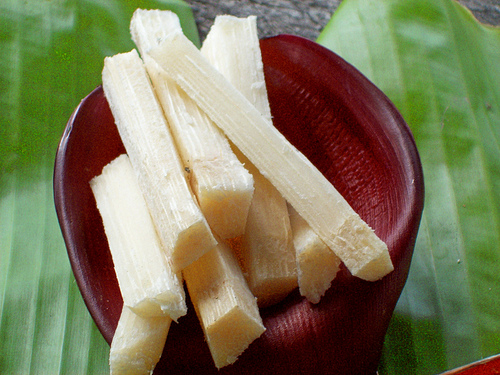The recent investigation done by journalists of Plaza Publica [1] in Guatemala has uncovered how government authorities, although legally having to prevent child labor, allow children under 14 years of age to work in their cane fields, which is a physically demanding and dangerous work.
 [2]
[2]
Sugar Cane Pieces [2] by Chris McBrien [3] CCBy [4]
In the article Child labor and exploitation in Guatemala's sugar [5] Alberto Arce and Martín Rodríguez Pellecer explain how children work in the sugar fields where workers are paid by tonnage cut. While most adult workers cut two to three tons, that doesn't even add up to minimum wage, about 7.5 USD per day. One of the families interviewed, where the father works with his two sons, one 12 and the other 13, don't even make minimum wage between the three of them.
Para llegar al salario mínimo, con un salario de Q20 por tonelada es necesario superar las tres toneladas diarias. Para el finquero, la media normal que un cortador puede extraer es de seis toneladas. Los cortadores dicen que a partir de dos o tres es inhumano.
Following is the short video [6]they shot as they went into a sugar cane plantation to take photographs using an antique wooden camera. From the article:
Plaza Pública ingresó sin pedir permiso a la propiedad privada de Kuhsiek para hacer unas fotografías artísticas sobre trabajadores de la caña. En ese momento, no se sabía quién era el dueño de la finca. Ya dentro se descubrió el trabajo infantil. Allí, en una conversación informal entre el empresario agrícola, uno de los reporteros que escriben esta nota y el fotógrafo Rodrigo Abd, se acordó una entrevista formal en su oficina de la capital.
The greatest irony is perhaps that the owner of the Flamenco plantation is no other than Otto Kuhsiek, the president of the Guatemalan Chamber of Agriculture. In the interview, he didn't deny that children may go to the fields, but suggested that they don't actually work there:
El presidente de la Cámara del Agro se define como una persona que trata de cumplir con la Ley: “No conozco las edades de los niños que se encontraban en mi finca, que estaban, en todo caso, en su período vacacional. Usted vio que había una escuela en frente de donde estaban. Y esos niños no son trabajadores, sino que vienen acompañando a sus padres. Son sus ayudantes (…) .
He went on to explain that workers are not exploited since they are free to go when they are tired. However, the journalists point out that at 5 pm workers can still be seen in the fields and because they are paid for what they can cut, they may be forced to chosing between feeding their families or getting some rest.
On twitter, under the hashtag #11deazucar [7], Guatemanal journalist Alejandra Gutierrez [8]tries to take the focus from placing blame into the lives of these children:
¿Los cañeros? ¿los azucareros? ¿los compradores? ¿los padres? ¿el Estado? La tragedia es que esos niños tengan que trabajar. #11deazucar
Child labor in the sugar cane fields is not new: back in 2007, this video [9] with pictures of sugar cane workers in Guatemala, including children was uploaded on YouTube.
Although the sugar industry in Guatemala is one of the fastest growing and highest grossing in Guatemala, this growth and wealth is not passed on to the people farther down in the chain. In fact, the sugar association that brings together the 13 sugar processing plants in Guatemala, Asazgua, only guarantees a minimum wage for those who work processing the sugar, not those who cut it and believes the problems of the cane workers exposed are neither examples of child labor or, in fact, their problem, since they are cutters and not sugar workers: since they are providers they are not part of Asazgua and it is not up to them to stop this from happening.
In the Plaza Publica article, Arce and Rodriguez tell of how the plantation owners and Asazgua show themselves as victims, suggesting that child work at the plantations is the farmers’ choice, and that not allowing children to work at the fields might lead to the farmers or their children burning down the fields and sabotage the production.
The article and investigation had results, but sadly, not as expected. Journalist Alberto Arce posted on [10] twitter [11] that althought the Finca Flamenco farm ceased operations as a consequence of the article on sugar in @PlazaPublicaGT, there are cane workers who lost their jobs in Retalhuleu.

